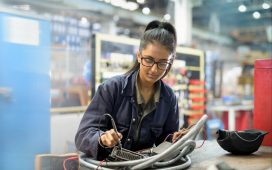
Predicting the future is already difficult. Now add in step-function changes of an industry, a … [+]
getty
There are no crystal balls. There are no Zoltar machines at arcades that will accurately tell the future. But for automotive marketing departments, they nevertheless must predict society’s needs five to ten years into the future. Connected? Autonomous? Electric? All of these transformative, step-function changes were already making 2020 a difficult year of soothsaying, and then POOF! Covid-19 hits, and all predictions based upon historical extrapolations seemingly become a metaphorical walk on an unsupported plank. Will ridesharing truly become non-existent? Will commuting miles be “a 20th century” thing? Will California’s 2035 edict and Tesla’s $25k vehicle make the electric vehicle real rather than an on-again, off-again governmental hope? And how will an explosive U.S. election affect the global marketplace? In the end, how do any of these companies look into that murky, translucent ball and boldly predict the distant future?
“Leaders at every organization need to be flexible and willing to step out of their comfort zone to change how they conduct business,” says Daniel Weissland, the President of Audi of America. “The automotive industry has historically been one of the more traditional industries. We are usually not that quick to shift and change our processes and mindsets. That’s been a big learning from the pandemic.”
Rapid change.
And what Audi as well as others have realized is the pivoting has a lot to do with listening. “What I think is most important here is to put the customer at the center of everything we do and in the center of our products,” says Weissland. “In the past, sometimes we would create products and then try to find the right customer. We as an organization have moved toward being customer-centric, which means becoming more flexible and agile.” When pressed about how easy or difficult it is to truly listen to customers that are sheltered-in-place, Weissland stated, “Surprisingly, I don’t think it’s more difficult to reach the customer right now. You probably could even say it’s easier since many [customers] spend a lot of time at home, they don’t travel as much, and they consume more social media and TV than pre-Covid. The way you interact with customers, though, has changed. Because of the pandemic, some customers are hesitant to visit dealerships right now. So, you basically need to adapt and offer remote services and online sales for the customer sitting on their couch at home who wants to specify their car and request a test drive at their house. We launched Audi At Your Door during the pandemic, which had elements in development pre-COVID, and we’ve seen a lot of success and demand from customers. Audi At Your Door offers customers a premium purchase and service experience with online communication and a remote vehicle pick-up and delivery options, and that came to life at an accelerated pace because of the health crisis.”

President of Audi of America, Daniel Weissland, attends a 2017 event in Toronto. (Photo by Sonia … [+]
WireImage
And that active, focused listening is not confined to the manufacturers. “In the pre-Covid world, everyone got excited with the once-in-a-century change that’s occurring in the industry as we moved towards new mobility,” states Rob Hempel, Vice President of Sales and Marketing at DENSO. “Whether it was propulsion with electric vehicles, or the ridesharing space or the connected world. Everyone was moving in a lot of different directions. What the pandemic has done, though, has created focus. The industry doesn’t currently have the luxury to throw around budget at exploratory projects. We have to listen even more closely to the customers – both the end market and the manufacturers – to learn where are their priorities. There’s a word that sometimes gets overused but I think it’s appropriate: harmonize. It’s important to harmonize what we find from the end users and the market versus what the manufacturer finds. If you don’t have that harmony, then you haven’t done your job yet as a key supplier. The pandemic has driven us to get creative on how we do our work virtually like with focus groups to collect user feedback and customer collaboration, but it eventually comes down to listening intently and acting.”
One area that both executives see continuing to thrive despite the oppressive pandemic or transformative election is electric vehicles. Weissland unequivocally stated, “Ultimately, we want to be there for our customers. Both me personally and Audi wants to move toward an electric and sustainable future. Climate change is a fact, it’s not a theory. Therefore, it is our responsibility as a company and a brand to invest heavily in an electric future. We want to be at the forefront and shouldn’t be afraid of what might happen politically.” Hempel also summed it up well by saying, “In the long-term, electric vehicles will happen. The mid-term and short-term questions are simply, ‘How quickly can we move there’ and ‘How much money is available to make that happen?’ All around the world, local governments can be a big enabler to making technology happen. Should California maintain the electric vehicle strategy they’ve put out there, the [manufacturers] don’t have a choice. If they want to be in that market, they must have an electric vehicle solution. So then it’s just a matter of the auto manufacturers being aligned with the government on what we collectively want to get done. There’s a lot of power in the collective.

The future could unfold in many different ways, but many predictions continue to include electrified … [+]
photo credit: DENSO Corporation
Another area where both predictions seem decisive is carsharing. “Some data is coming in that car-sharing will be a greater need than ridesharing,” says Hempel. “Customers are saying, ‘I feel a whole lot safer driving in a single car that I manage for a given amount of time than jumping into a car with a bunch of other people,’ but we have to take some time to really understand where the right solutions are going.” Weissland’s data supports the same theory. “People feel more comfortable in sanitized, private mobility than a public solution as long as they can afford it. Personal mobility is still one of the basics that people need to have, especially now with public transportation on a huge decline within the pandemic. Here we recently introduced Silvercar by Audi at participating dealerships, so no matter if you want a car for a day, a week, for months or for years, we are able to offer to the customer whatever they want. We still have dealerships providing the traditional ‘buy a car’ or ‘service a car’, and now we have some going to the next step of being a mobility provider. I’m excited about the opportunities that it’s provided our new and existing customers.”
When asked how many of these changes to society will be permanent, the answers were positive. Weissland felt “… many of these changes will be permanent and maybe were already starting to form pre-Covid. Especially on the service side, we have seen interest in the remote services. Not just for the want to shelter and maintain social distance, but for many people time is their most valuable asset.”
Hempel was equally optimistic. “There are aspects of ‘connected’ or ‘autonomous’ that will continue no matter what. [The pandemic might force] incremental changes instead of the step-function changes such that incremental changes will appear more like continuous improvement. Either way, the world is still moving, and nothing has told me that’s going to change. We haven’t lost sight of a lot of exciting things that are down the road. I am eager about getting through this period and taking the world to the next era.”








